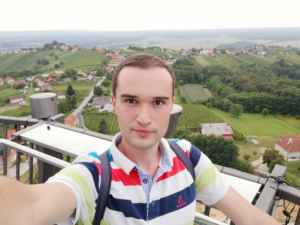
Dr. Jurij Sablić
Host beneficiary: Departament de Física de la Matèria Condensada, University of Barcelona, Spain
Industrial partner: Unilever, UK
Description
In this pilot project, we study phoretic phenomena in heterogeneous fluids. Diffusiophoresis is a spontaneous motion of colloids within a solution, which is caused by the concentration gradient of the solute within the solvent. This effect may result in pore clogging and particle trapping and is potentially applicable in membrane-less water filtration. Diffusioosmosis is a similar phenomenon, occurring in solutions with the presence of solid walls. The interaction of the fluid with the wall gives rise to the bulk flow of the fluid, whenever there is a concentration gradient of solute in solvent. Diffusioosmosis becomes relevant in systems with large surface-to-volume ratio, such as microfluidic devices, nanoporous membranes and porous media. The letter are of particular interest to our industrial partner Unilever, with whom we collaborate in the research of binary fluid flow through pores near the liquid-liquid critical point.
We perform simulations of diffusiophoretic and diffusoosmotic phenomena with the Lattice-Boltzmann method. This is a mesoscopic method that solves the Lattice-Boltzmann equation at every point of the discretised computational domain, ensuring the correct description of the hydrodynamic (i.e. macroscopic) properties of the simulated fluid. Furthermore, the method enables the coupling of hydrodynamics with the free-energy based models. In our studies, we thus describe the binary fluid in terms of a Ginzburg-Landau free energy functional, with an additional implementation of externally imposed chemical potential gradient, which is equivalent to the concentration gradient of the experimental set-up. All simulations are performed by the simulation package Ludwig.
Development Plan
List of Tasks
- Implementation of an external chemical potential gradient into Ludwig for the studies of diffusoosmosis
- used for the studies of chemoosmosis
- implementation in subroutines of Cahn-Hilliard solver and thermodynamic fluid force calculation, based of gradient of chemical potential
- described in module 1
- Creation of crystalline geometries in Ludwig
- used to research porous media
- described in module 2
- Implementation of an external chemical potential gradient into Ludwig for the studies of diffusophoresis
- used for the studies of chemophoresis
- additional implementation in subroutines of thermodynamic fluid force calculation, based on divergence of pressure tensor, and of colloid dynamics
- work in progress
- Study diffusophoresis and diffusoosmosis in binary fluid systems
- work in progress
- Study of binary fluid flow in porous materials
- determination of Onsager matrix
- study the behavior near liquid-liquid critical point
- work in progress
- Improving the scalability and load balancing performance of simulations of porous media
- Adapt E-CAM's Load Balancing Library (ALL) to Ludwig
- future plan
List of Modules
Module 1: Externally imposed chemical potential gradient for binary fluid mixture
Status: submitted, under review (Merge request)
Description: This module implements an externally imposed chemical potential gradient to Ludwig as a physical property, which is further used in Cahn-Hilliard solver and the subroutine that calculates the thermodynamic force on fluid, using the gradient of chemical potential. The module enables the studies of diffusoosmotic flows in porous materials.
Module 2: Implementation of crystalline capillaries
Status: submitted, under review (Merge request)
Description: This module implements simple cubic (SCC), body-centered cubic (BCC), and face-centered cubic (FCC) crystalline geometries as a utility to create capillaries in Ludwig. The thus created crystalline geometries are used as porous materials in Lattice–Boltzmann simulations.
